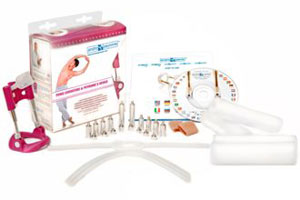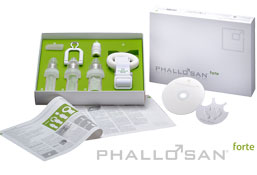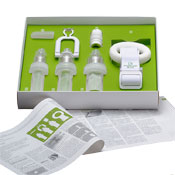Penis Traction Device
For Treating Peyronie's Disease
Using penis traction device to treat Peyronie's disease is becoming increasingly popular treatment option.
This is though relatively recent development but the initial indications from scientific studies have been favorable. Penile traction device have shown to be effective in improving penis curvature and indentation deformity.
Here I explain how a penis traction device work for men with Peyronie's disease, go through the main benefits and possible downsides, reported results and look at support from scientific studies.
This article covers the following topics:
What Is Penis Traction Device?
Penis stretching devices include plastic ring that fits around the base of your penis. The ring is fastened to two movable metal rods that apply tensions outward by putting pressure on a plastic support that rests against the body.

Penile traction device uses gentle but consistent traction to stretch the penis tissues.
This triggers the body's natural response of growing more tissue to ease the tension, i.e. when you stretch soft tissue it responds by growing new soft tissue.
The original purpose of penile extenders is to lengthen the penis and / or gain penis girth.
In recent years, penis enlargement extenders have increasingly been used to treat penis curvature in men with Peyronie's disease.
The most reputable penis extender brands have therefore adjusted their penis stretching devices to better suit men with Peyronie's disease. They allow you to control the direction of the traction by applying stronger force to the side of the curvature and hence help the penis to straighten up.
How To Use
Penile Extenders For Peyronie's Disease
For men with Peyronie's disease the main purpose of using penis stretching device is to reduce the penis curvature, less to increase the length or girth... most consider that as additional bonus.
However, lengthening is of value as well, as penis shortening is a common consequence for men with Peyronie's disease.
The use of penis traction devices for Peyronie's patients is based on the rationale that tension from stretching may lead to reduction in the penile curvature by triggering the body's natural response of growing more tissue to ease the tension.
The more you use your penis extender and the more tension you apply determines the success you can expect. It is however vital to follow the instructions carefully. You should not use your penis enlargement extender longer than recommended and tension should be applied gradually.
Most reputable penile extender manufacturers recommend starting slowly and increase the time gradually until using it for 8-9 hours daily.
Each traction session should not last longer than 2 hours, with a minimum 20 minutes break between sessions. You should start with mild traction and gradually increase the tension as instructed.
What Are The Benefits
Of Peyronie's Penis Extender Treatment?
Using penile extender to treat Peyronie's is non-invasive, non-surgical option and you can get medically approved devices. It is easy to use them and patients satisfaction tends to be high.
Improvements to the penile curvature may be sustained after treatment, i.e. the result tends to be permanent.
The cost of penis traction treatment includes only the cost of the penile extender, i.e. there are no expensive doctor's visits or drugs required.
Meaning, Peyronie's penis extender treatment is one of the cheaper Peyronie's treatment options available.
What Are The Downsides
Of Peyronie's Penis Extender Treatment?
The main downside of using penis traction device to treat Peyronie's disease is the time and commitment required. The more you use your penis enlargement device, the better result you can expect.
Wearing external penis extender for long periods can be unpractical for some men, e.g. for those doing physical work. Those might want to combine the use of penis extender with the use of vacuum pump, i.e. use the traction device during evenings and weekends but the vacuum pump in between.
What Are Side Effects Of Penis Traction Device?
Penis enlargement extenders are generally well tolerated though it is important to follow the directions closely and take breaks every 2 hours. Possible side effects may include itching and sore penis head.
Does Penis Extender Involve Any Health Risk?
Penis extenders are classified as non-invasive and low risk stretching device.
I personally would only use medically approved traction device, as Peyronie's disease is a medical condition. The last thing you want is to do something that can make your Peyronie's condition worse.
Do Penis Enlargement Devices Work?
There tends to be high patients satisfaction among men that use penile extenders to treat their Peyronie's disease.
Penis traction devices have been used successfully for years to lengthen penises (average 1-2 inches) and increase penis girth. As such, it can be beneficial for men with Peyronie's disease that have experienced penile shortening, e.g. after Peyronie's surgery. Some urologist specialists therefore recommend to their patients to use penile extenders as part of their Post Peyronie's Surgery Therapy.
Penis stretching devices have also shown to improve penis curvature and indentation deformity in men with Peyronie's disease.
There is no question that penis traction device works well for men with the disease. I know, as I am one of them, read My Peyronie's Story.
You can also read about Bob's Experience Of Using Andropeyronie to treat his Peyronie's disease.
Dr. Levine, one of the best-known Peyronie's specialists in the world today, says evidence now show that traction device may be the most important non-surgical treatment available to men with Peyronie's disease.
Dr. Levine now recommends traction therapy for all his non-surgical patients. He also recommends using it before (if possible) and after penis penis surgery.
I highly recommend viewing Dr. Levine's video about Penis Traction Therapy ![]() for men with Peyronie's disease (the first video under the section Physician Videos).
for men with Peyronie's disease (the first video under the section Physician Videos).
Scientific Support For Peyronie's Penis Extender Treatment
Using penis traction device for treating men with Peyronie's is relatively recent treatment development, meaning lack of controlled studies (currently underway). Early evidence from some small non-controlled prospective trials have been quite favorable and reported reduction of deformity and increased penile length.
A recent review (February 2013) of current publications into penile traction therapy and Peyronie's disease, offers good overview and links to studies to date. The conclusion is favorable or as said in the abstract:
“The current published literature suggests that selected cases of PD may benefit from a conservative approach with PTT, resulting in increased penile length and reduction of penile deformity. It appears to be safe and well tolerated but requires a great deal of patient compliance and determination”(Ther Adv Urol. 2013 February)
Newer study (November 2013) looked into the outcome of using penile traction therapy (PTT) for the acute phase (AP) of Peyronie's disease. Their conclusion was very favorable:
"PTT seems an effective treatment for the AP of PD in terms of pain reduction, penile curvature decrease, and improvement in sexual function" (J Sex Med. 2013)
The mean curvature decreased from 33 degrees to 15 degrees at 6 months and the VAS score (visual analog scale) for pain decreased from 5.5 to 2.5. Erectile function and erection hardness also improved significantly. The percentage of patients not able to achieve penetration decreased from 62% to 20%.
The penile traction therapy was associated with the disappearance of sonographic plaques in 48% of patients and the need of surgery was reduced in 40% of patients.
In the group that did not receive any treatment (the NIG group), deformity increased significantly, stretched flaccid penile length decreased, VAS score for pain increased, and erectile function and erection hardness worsened.
Laurence A. Levine, MD, is one of the best-known Peyronie's experts in the world today. In his most recent review (2011) of the non-surgical treatment options for Peyronie's disease, he and his partner, S. M. Larsen, conclude:
“At this time, it appears that a combination of oral agents and/or intralesional injection with traction therapy may provide a synergy between the chemical effects of the drugs and the mechanical effects of traction” (International Journal of Impotence Research (2012))
In another article, Dr. Levine concludes:
“On the other hand, external traction therapy has been shown in recent studies to provide a reduction of curvature and recovery of lost length. Traction therapy remains an attractive non-invasive treatment...
Therefore the goals of penile traction therapy for PD include stopping progression of scarring, recovering length and girth, reducing curvature, enhancing sexual function, and possibly avoiding or simplifying surgery by taking someone with a severe deformity which may require grafting, and reducing it to a curvature which would respond better to a less risky operation known as plication” (SexualMed.org)
Based on this, Dr. Levine recommends Combined Nonsurgical Treatments to his patients that include oral medication, injections, and the use of penis traction device.
More research is underway but more and more studies are confirming the efficacy of using penis traction devices to treat men with Peyronie's disease. The high satisfaction rate among Peyronie's patients is also encouraging.
My Personal Experience
And Opinion Of Using Penis Stretching Devices
I used Andropeyronie penis extender as the main treatment for my Peyronie's.
I did not measure my penis length or curvature before or after my treatment. Because of that I cannot say for sure in % terms how much my condition improved as a result of my penis traction treatment.
I would though estimate my curvature to have been +/- 40 degrees before starting using Andropeyronie. My penis is almost straight now (slightly bent upwards left) and it did gain back its former length and some more. It has also become slightly thicker than before.
The improvement is clearly noticeable to my wife and me, which is the main thing. And as only 5 - 15% of Peyronie's cases resolve themselves without any treatment, I'm very glad I took the decision of using traction device as part of my Peyronie's treatment.
Would I use penis traction device again to treat my Peyronie's disease? Yes, without hesitation, and I would possibly combine the treatment with other non-surgical options.

You can read all about My Andropeyronie traction device experience and pick up some practical tips for using penis-stretching devices to treat your Peyronie's disease.
Since my Peyronie's treatment, new traction devices suitable for men with Peyronie's disease have become available. The Peyronies Device is another good traction device designed to treat penis curvature.
Phallosan Forte vacuum protector system is also an interesting option for men with Peyronie's disease.
I personally find these three devices the best traction devices for men with Peyronie's disease, based on my experience but I have personally inspected and tried them all on.
Where To Buy Traction Device?
You can buy your traction device directly from / through this website. If you do that, you support my effort in maintaining this free website to support other Peyronie's sufferers. The price is the same as if you buy directly from the manufacturer.










Comments
Comment on this article
Have you used penile extender in your fight against the Peyronie's disease? Share your experience.